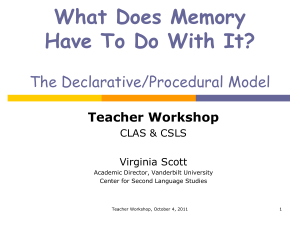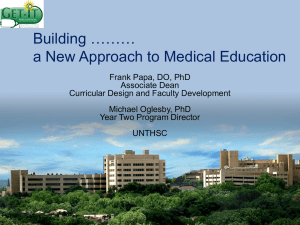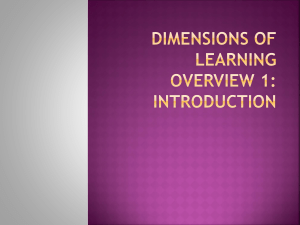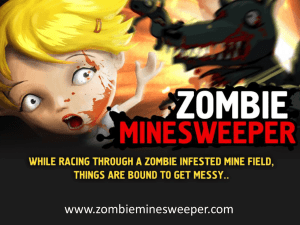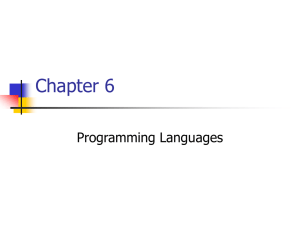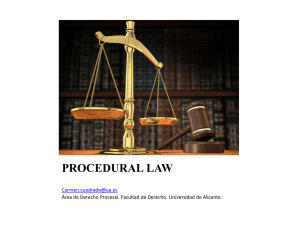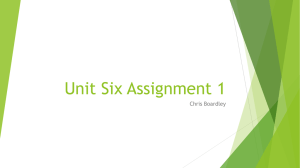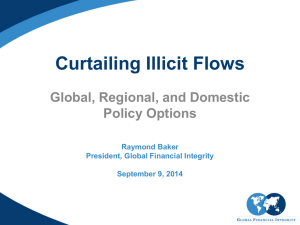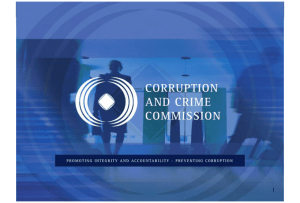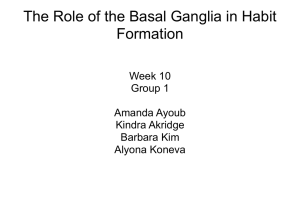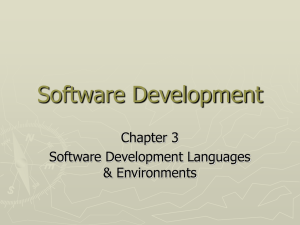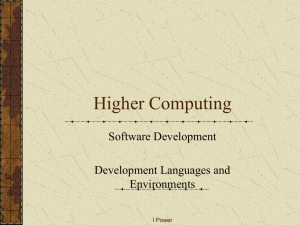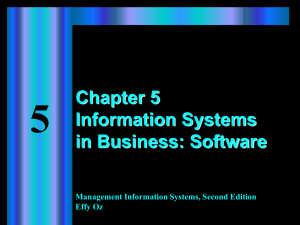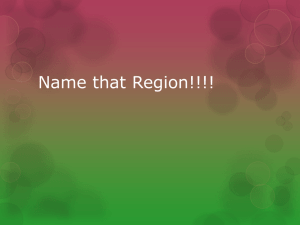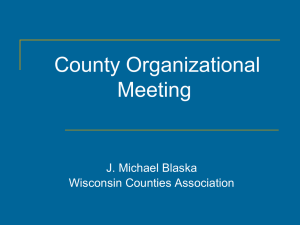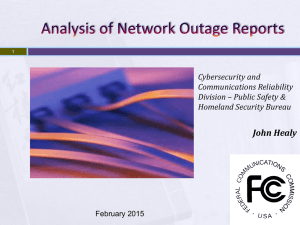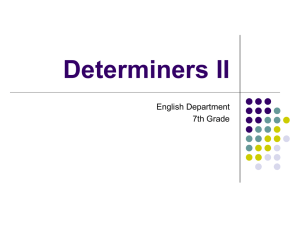Erika`s slides
advertisement
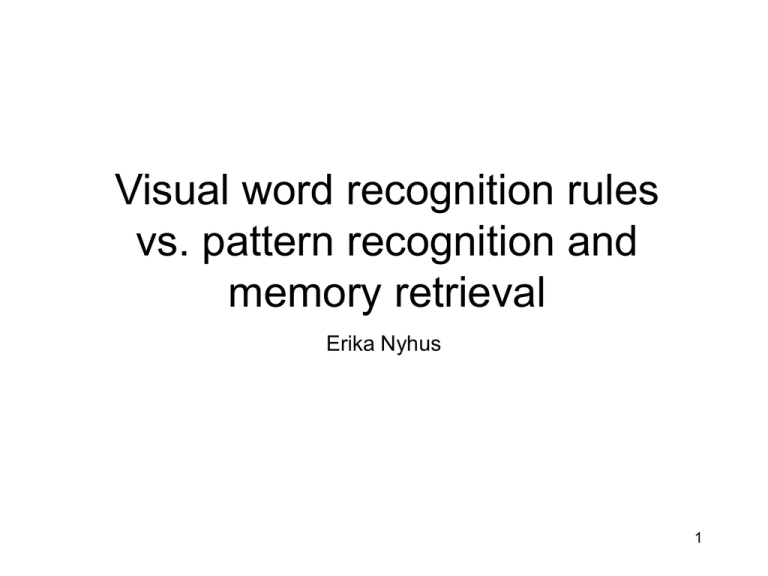
Visual word recognition rules vs. pattern recognition and memory retrieval Erika Nyhus 1 Ullman, 2004 • Language is usually studied as a unique process. • But brain connectivity and evolution suggest that brain areas can process information in many domains. • Suggests that understanding of language processing can be enhanced by studying it in relation to other domains. • And understanding of other domains can be enhanced by studying them in relation to language. 2 Introduction • Contrasts mental lexicon and grammar: – Mental lexicon: A repository of all idiosyncratic wordspecific information – Grammar: Rule based sequential ordering and hierarchical relationships 3 Types of Memory Memory Declarative Episodic - Events Semantic - Facts Non-Declarative Priming Procedural Learning Conditioning 4 Memory Structures • Declarative memory is supported by temporal lobe structures: Hippocampus, entorhinal cortex, perirhinal cortex, parahippocampal cortex, mammilary bodies, and thalamus. – These structures are important for encoding, consolidation and retrieval of declarative memories • Procedural memory is supported by frontal lobe structures: Supplementary motor area and Broca’s area, basal ganglia, parietal lobe, superior temporal cortex, and cerebellum – These structures are important for working memory, sequencing, motion detection etc. of procedural memories 5 Frontal Lobe Parietal Lobe Basal ganglia Mammilary bodies Thalamus Cerebellum Hippocampus Entorhinal, perirhinal, parahippocampal cortex 6 Declarative/Procedural Model • There are striking similarities between mental lexicon/grammar and declarative/procedural memory • Suggests that these two language processes are supported by two memory systems: – Mental lexicon relies on declarative memory systems – Grammar depends on procedural memory systems 7 Clarifications of Model • Not all declarative and procedural memory brain areas are involved in language • Language may also need other brain areas • And even in shared regions there are special sub-regions: – Domain general regions – Domain specific sub-regions 8 Neuroimaging Evidence • PET and fMRI studies show: – Temporal lobe activation for semantic/conceptual linguistic and non-linguistic information – Frontal and basal ganglia activation for syntax and procedural learning • ERP studies show: – N400 for difficult semantic and lexical processing – Left anterior negativities (LAN) and P600 greater for anomolous syntax and procedural performance 9 “Language” Disorders Evidence • Specific Language Impairment (SLI): – Impaired at syntax and procedural memory tasks – Disorder has been linked to abnormalities in brain areas that overlap with procedural memory structures: Broca’s, basal ganglia, supplementary motor area, and the cerebellum 10 “Language” Disorders Evidence • Fluent aphasia: – Impaired at production, reading and recognition of words and conceptual knowledge – Disorder linked to damage in brain areas that overlap with declarative memory structures: Left temporal and temporal-parietal regions • Non-fluent aphasia: – Impaired at grammar and procedural memory tasks – Disorder has been linked to damage in brain areas that overlap with procedural memory structures: Left inferior frontal regions, Broca’s area, and nearby cortex 11 “Non - Language” Disorders Evidence • ADHD, autism, and dyslexia: – Impaired at motor functioning – Disorder has been linked to damage in brain areas that overlap with procedural memory structures: Basal ganglia and cerebellum 12 “Non - Language” Disorders Evidence • Alzheimer’s Disease: – Impaired at lexical and declarative memory – Disorder linked to damage in brain areas that overlap with declarative memory structures: Medial and neocortical temporal lobe structures • Parkinson’s disease: – Impaired at grammar processing and hypokinesia – Disorder linked to damage in brain areas that overlap with procedural memory structures: Basal ganglia 13 “Non - Language” Disorders Evidence • Huntington’s Disease: – Impaired at grammar processing and hyperkinesia – Disorder linked to damage in brain areas that overlap with procedural memory structures: Basal ganglia • Amnesia: – Impaired at acquiring lexical and semantic knowledge – Disorder linked to damage in brain areas that overlap with declarative memory structures: Temporal lobe 14 Conclusions • Understanding of language processing can be enhanced by studying it in relation to other domains. • And understanding of other domains can be enhanced by studying them in relation to language. • This understanding can be used to develop treatments for disorders. 15 MacWhinney, 2005 • Argues against some of the claims made by Ullman. • Symbolic rule based processing – The rules should be “combination” • Emphasizes interactions between declarative/procedural model cognitive modules – Refers to neural areas rather than modules 16 Ullman’s core propositions 1. 2. 3. 4. 5. The brain is a symbol manipulation system The brain implements linguistic rules The formation of words by rote and the formation of words by rule are computed in separate cognitive modules Rote is processes in posterior areas and rules are processed in anterior areas Brain organization to support this dissociation between rote and rule is domain-specific adaptation that was required for the evolution of human language 17 MacWhinney’s Revised Propositions 1. 2. 3. 4. The brain combines lexical forms The brain implements rote lexical retrieval The formation of words by rote or combination is computed in separate neural areas Rote is processes in posterior areas and combinations are processed in anterior areas 18 Conclusions • Need to get rid of idea of symbolic systems, modularity, rules, and domain-specificity • With these barriers removed we can conceptualize and test predictions about the dual route model 19 General Conclusions • There is strong evidence that underlying processes of language and memory overlap • And that language and memory share similar brain structures • But it is unlikely that the grammar system uses rules • And it is likely that these systems are not modular but interact and share processing demands with other domains 20 Discussion • How similar are the underlying processes of language and memory? • Are there language processes not related to memory and memory processes not related to language? • How can these two Ullman and MacWhinney’s standpoints be resolved? • Without rules, how are combinations of words achieved grammatically? 21
